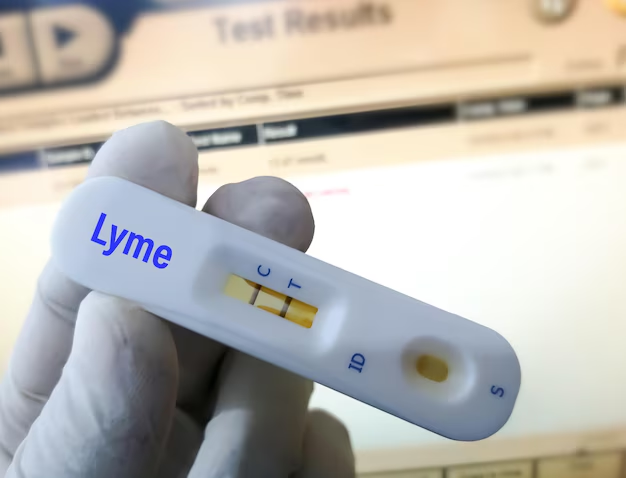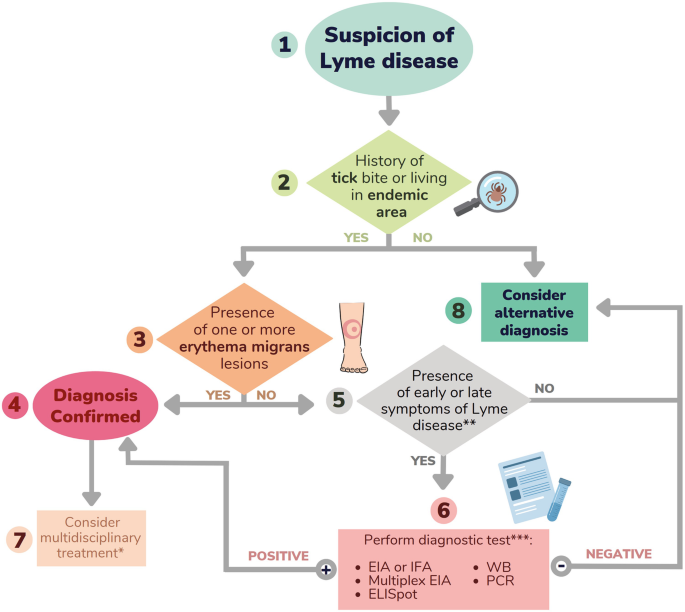Diagnosing For Lyme Disease
Tests and Procedures


Diagnosing Lyme disease at an early stage is crucial to avoid complications. However some of the symptoms of lyme disease are not straight forward; it can mimic other viral diseases. There is no specific lyme test available to confirm. Then how to provide effective treatment. Reading this blog helps you to get some insights on Diagnosis for Lyme disease testing options that will help you make informed diagnostic decisions.
Understanding Lyme Disease
Lyme disease is an infection caused by the bite of an infected black-legged tick or deer tick. It is a tick-borne illness where the tick transmits bacterium Borrelia burgdorferi through its saliva into our bloodstream. It may lead to various mild symptoms at the early symptoms and can result in serious illness if left untreated.
Lyme Disease have the following common symptoms:
The first stage
In this stage one may experience fatigue, fever, ache on the body, chills, headache and a bull’s eye rash known as Erythema Migrans (EM).
The second stage
With days passed by in addition to that it may cause neurological symptoms, pain in the joints and even more rashes.
The third stage
It is a serious stage with complications and has symptoms like pain from chronic arthritis, severe headache, memory issues and more.
Early diagnosis always helps in preventing severe complications that is the case for Lyme disease also. If left untreated the disease progresses to advanced stages affecting various organs like joints, heart, and nervous system, leading to long-time suffering. Early intervention can significantly reduce the risk of chronic symptoms and improve treatment outcomes.
However, diagnosing Lyme disease in its early stages poses unique challenges due to several factors:
The Importance of Early Diagnosis
Timely diagnosis is critical in managing Lyme disease and preventing severe complications. When left untreated, Lyme disease can progress to advanced stages, affecting vital organs like the joints, heart, and nervous system, leading to debilitating long-term issues. Early intervention can significantly reduce the risk of chronic symptoms and improve treatment outcomes.
However, diagnosing Lyme disease in its early stages poses unique challenges due to several factors:
Overlap with Other Conditions
- Sometimes symptoms such as fever, fatigue, and joint pain are often considered illnesses like the flu or autoimmune disorders. It makes clinical diagnosis difficult.
Unnoticed Tick Bites
- When people are unaware of being bitten by a tick due to the painless bite or small size tick, it may delay the recognition of the disease.
Erythema Migrans (EM) Rash
- The "bull's-eye" rash is a hallmark symptom but appears in only 70-80% of cases.
- In some individuals, the rash may be atypical or go unnoticed.
These challenges result in delay in Lyme diagnosis. But still early clinical assessment and the appropriate use of reliable testing methods Lyme diagnosis can be diagnosed.
An Overview Of Lyme Disease Testing Techniques

When it comes to lyme disease testing, the methods involve looking for various markers of the infection such as antibodies,
the DNA of the bacteria, or culture growth.
The following are some of the important methodologies in Lyme testing:
A. Serological Tests (Antibody Tests)
These tests measure the immune response mounted by the body in response to the bacteria.
1. ELISA Test (Enzyme-Linked Immunosorbent Assay):
- The test looks for the antibody directed against Borrelia burgdorferi.
- Usually the first component of diagnostic protocols as it is very sensitive.
- While useful, the ELISA test can occasionally provide inaccurate results, especially during the onset of Lyme disease, leading to false positives or false negatives.
2. Western Blot Test
- This test is also conducted to confirm an ELISA positive result.
- It recognizes some specific proteins (antibodies) that the immune system produces in response to infection with Lyme bacteria.
The ELISA test and the Western Blot test are combined together to form what is referred to as a two step testing by the CDC to diagnose Lyme disease.
B. Polymerase Chain Reaction (PCR) Tests
- Detects the DNA of the bacteria from the blood or cerebrospinal fluid.
- Useful in cases where the patient has negative antibody tests but the clinical symptoms still persist.
- Limitations: Has relatively low sensitivity to Lyme bacteria in the blood sample and therefore not preferred for diagnosis.
C. Culture Tests
- Aim to isolate and grow Borrelia burgdorferi from specimens provided by patients.
- Considered the gold standard in many bacterial infections but rarely used for Lyme due to difficulty in culturing the organism.
Examining Reliability of the Test
Several issues influence the reliability of the test for tick – borne diseases:
A. Sensitivity and Specificity:
- Sensitivity refers to the people who test positive are actually infected.
- Specificity, on the other hand, means those negatively diagnosed people should be identified.
In the case of Lyme disease, there is a chance of getting a false negative as a result of unintentional neglect, therefore, a test that is sensitive enough is a must.
B. Timing of Testing:
- Antibodies are not developed immediately after infection. Testing too soon can produce false negative results.
- To obtain accurate test results, it is better to refrain from antibody based tests such as ELISA or Western Blot for about four to six weeks after infection.
B. FDA Cleared Assays:
- False claims about treatments are minimized if only FDA cleared assays are used.
- According to the CDC (Centers for Disease Control), these recommendations are appropriate when performing a two-phase testing approach ELISA followed by Western Blot testing methodology.

New Diagnostic Methods
To obtain accurate results from Lyme disease tests researchers are working on new technologies.
Other alternative solutions are also explored to replace current testing methods.
Some of these include:
1. Direct Detection Tests:
- Set out to detect bacterial proteins or DNA or detection of antibodies (i.e., the body’s response) directly without the requirement
- Includes advanced methods of PCR and mass spectrometry techniques.
2. Biomarker-Based Tests:
- Tests that look for Lyme disease related rare blood proteins.
- Still remain in the experimental phase but are likely to yield projections with higher chances of success.
3. Point-of-Care Tests:
- These tests target the recipient in a clinical or field setting and are made portable enabling them to have fast results.
- Aims on enabling quick and accessible testing for Lyme disease.
Advancements and improvements in the tests for lyme disease have made up its place forward in accurate diagnosis in future.
Conclusion
Diagnosing Lyme disease in the early stage is crucial and challenging. It requires a combination of clinical assessments and reliable testing methods. ELISA test and Western Blot test are accepted as the global standards in terms of current Lyme diagnosis protocols. Timely intervention with effective treatment and accurate diagnosis help in managing this complicated tick-borne disease.
If you suspect Lyme disease, Consult a licensed health care provider for the proper care and better advice of your health condition. The knowledge about the various tests and their treatment options maximizes the opportunity to diagnose early and heal the condition.
